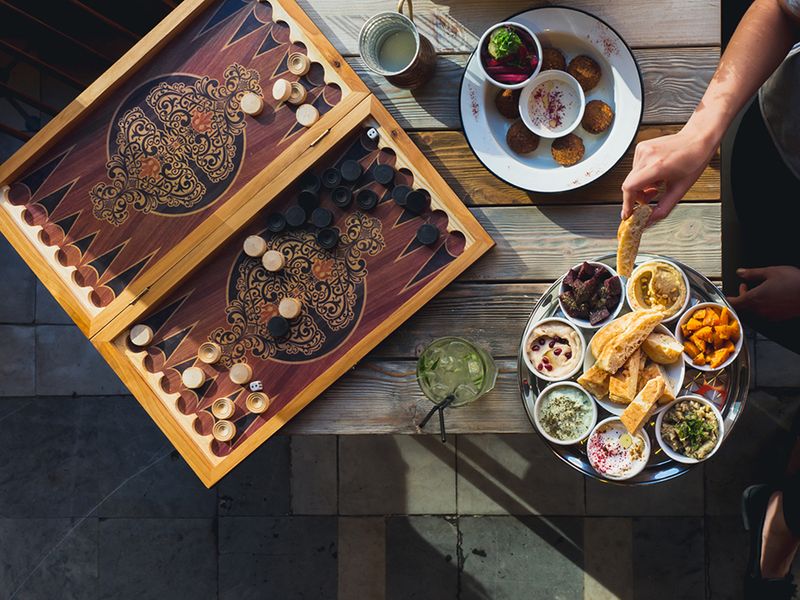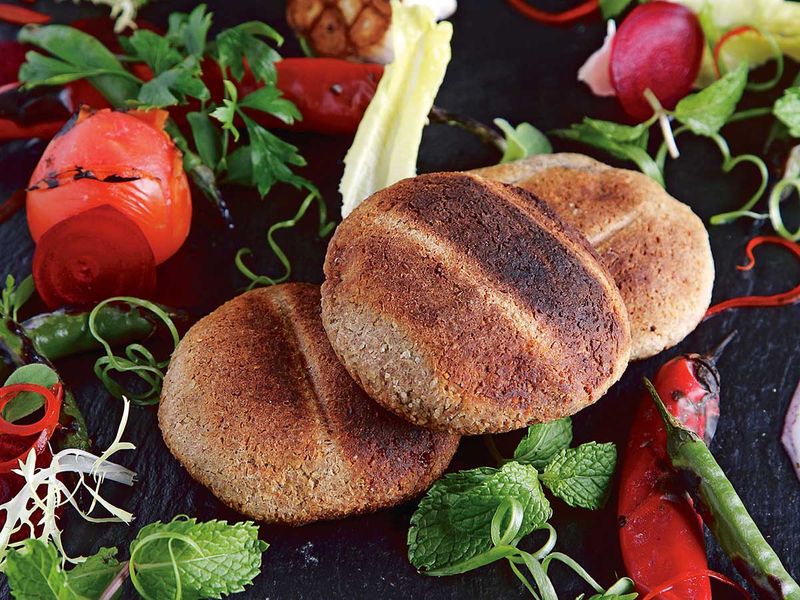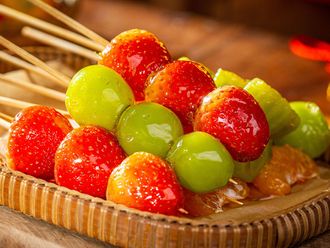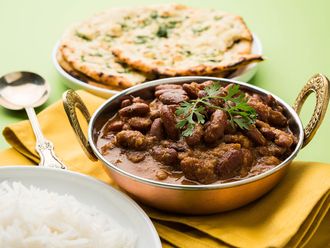
A bowl of mildly salted fresh olives – green and black, red grapes and sliced figs arranged next to a bowl of fresh labneh served with cucumber sticks and cheeses. The Lebanese mezze or a selection of small dishes as appetizers is only a small part of the Levantine cuisine, but it reflects the importance of how small and colourful dishes can make for a hearty meal.
A famous Arabic proverb, ‘The eye eats before the mouth’, holds true for Lebanese cuisine - a sensory celebration.
Mezze comprises vegetarian, meat and seafood items, usually served together and in groups at a typical food gathering. Be it at home or in a restaurant, a set pattern of olives, tahini, yogurt, salad, vegetables, and eggs will be followed by meat dishes. The dishes could vary from region to region but the serving structure remains the same.

The global appeal
Rabih of beirutfood, a popular Lebanese food blogger, told Food by Gulf News: “The mezze concept defines Lebanese cuisine. The concept of sharing small dishes including appetisers and main platters is always available. In every country you can find a small Lebanese restaurant serving traditional Lebanese foods such as falafel and shawarma.”
Talking about how this cuisine has become global, Samer Zayat, CEO and Managing Director of the restaurant Al Beiruti in Dubai, said: “Travelers and immigrants sharing their culinary secrets from all parts of Lebanon to the world has made the cuisine a popular international choice for many. Lebanese cuisine is very unique and most known for the variety it has to offer from zesty salads, delicious dips, diverse mezza and perfectly executed grills.”
Talks about the popularity of Lebanese cuisine
In fact, in the 1950s, Lebanon came to be known as ‘Switzerland of the East’. An increase in tourism in its capital city of Beirut, boosted the nation’s food, driving up its global popularity.
Influences from millennia
Lebanon has been home to different civilisations – starting from the Canaanite (people who lived in the land of Canaan, Bronze age 3300 BC to 1200 BC), Phoenicians (2500 BC civilization of Levant), Assyrians (Mesopotamian kingdom 2500 BC), Iranians, Greeks, Romans, Fatimids (a dynasty of Arab origin), the Ottoman Turks and its last colonial French rule in 1943 has greatly influenced modern-day food culture. For instance: “You can see a lot of French desserts like custard, flan and croissants, which is not Mediterranean but popular across Lebanese homes and bakeries,” explained Cynthia Bou Khalil, a nutrionist based in Dubai.
Healthy, Mediterranean diet
Lebanese food rarely uses heavy sauces, cream and butter, which also makes it one of the healthiest cuisines in the world. Khalil said: “The food has a lot of chickpeas, legumes, garlic and onion in a lot of dishes. Everyday cooked food has a lot of seasonal vegetables, salad is always present, and be it tabbouleh or fattoush. Appetisers such a baba ganoush (roasted eggplants with tahini or roasted sesame paste, white vinegar and garlic), hummus (mashed chickpeas in tahini and olive oil) are packed in calcium, fiber and other vital nutrients.” Apart from being healthy, a Mediterranean diet is known to help people with heart disease, diabetes and improve the quality of life in general, she explained.
Nutritionist's take on Lebanese food and childhood memories of eating it
“I am into healthy eating or what is popularly known as healthy eating. With Lebanese food, I can get to eat a variety of dishes. Being a pescatarian (a diet where a person eats only seafood), I think the cuisine offers vegetarians, vegans and people a lot of tasty options to choose from,” said Zeynab Attieh, a 26-year-old PhD student studying business management in the United Kingdom.
Here is a recipe to make the classic Hummus Beiruti:
According to togetherwomenrise.org the Lebanese diet is rich in grains, vegetables, legumes, fruits and nuts, which form the pantry staple in every home.
A combination of herbs, spices and are used moderately in preparing dishes. Mint, parsley, garlic, oregano, nutmeg, cinnamon are the most commonly used seasonings. The famous Lebanese all-spice mix consists of black pepper, allspice, cinnamon, cloves, nutmeg, ginger, and fenugreek. “Olive oil, chickpeas and sesame paste are core ingredients in many of the dishes and mezzes,” said Chef Samer Karkanawi at Grand Beirut restaurant, Abu Dhabi.
About Lebanese food
Karkanawi talked about the importance of seasonal fruits and vegetables in dishes, too. “Maintaining the freshness of products is crucial. We receive our vegetables and produce on a daily basis, we always seek fresh items that are in season, hence the diverse seasonal menu seen in Lebanese cuisine.”
All this talk about vegetables doesn’t mean meat doesn’t play a role – it is a key element.
Meat dishes are made from lamb, chicken and beef. With lamb being the main source of animal meat protein. Some of the popular methods of preparing meats are grilling, baking and to a lesser extent sautéing.
And then there’s kibbeh…
It’s raw meat, it’s seasoned – it’s kibbeh. According to Maureen Abood an international recipe developer on npr.org: “Kibbeh nayeh is made of minced raw lamb or beef, combined with bulgur or cracked wheat, pureed onion and a mix of spices that partly depends on the cook. All of the ingredients are kneaded together with a sprinkling of iced water, and then eaten — with olive oil, a scattering of chopped sweet onion, bundled in flatbread ….”

So sacrosanct is this dish that even to this day, many butchers in Lebanon pound meat for kibbeh using the traditional mortar and pestle.
The romance of bread
No Lebanese meal is complete without bread – literally the factor that binds all the layers of tastes.
From big to small, every baker wakes up early in Lebanon to make manakeesh - flatbread made from whole-wheat flour, filled with cheese and smeared with zaatar (a savoury dried powder made with cumin, thyme, cumin, coriander, sesame seed, sumac and kosher salt.
Khalil said: “Waking up to the smell of freshly brewed coffee (Kahweh) and fresh bread on a weekend is a memory I fondly recall from my childhood. We sometimes have bread for lunch and dinners.”
The Lebanese table
“As a Lebanese, what I and everyone growing up will remember is how we would have an abundance of food on the table, be it a festival or an everyday visit by the neighbors. The table would be filled with appetisers, hummus, salad, eggplant dishes, and fresh onions to begin with. Another thing which is always present in every Lebanese food is bread.
Attieh added: “Lebanese food to me is about those gatherings and family laughter I get to share with my loved ones. Whenever I go to Beirut during summers, I tell my friends to book a restaurant for lunch and dinner so that we can sit, eat and have a good time. It’s these memories that I crave later, shared over food.”
On Lebanese food
Her multicultural upbringing and mixed ethnicity like many others from her country makes celebrations and festivals in Lebanon diverse. “Eating is a communal affair for the Lebanese.”
Here is a guide to making moutabal.


















